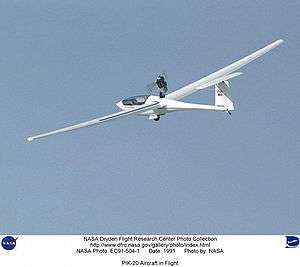Eiri-Avion PIK-20
The PIK-20 sailplane was designed at the Helsinki University of Technology by Pekka Tammi, with advice from Ilkka Rantasalo and Raimo Nurminen. The prototype first flew in October 1973. It was produced initially by Molino Oy who were taken over by Eiri-Avion Oy (Currently Eirikuva Oy between 1974 and 1980. Later, production was taken over by the French company, Siren SA, under the name Siren PIK-20.
| PIK-20 | |
|---|---|
 | |
| A self-launching PIK-20E at the Dryden Flight Research Center | |
| Role | Standard-class (later 15 metre-class) sailplane |
| National origin | Finland |
| Manufacturer | Eiri-Avion |
| Designer | Polyteknikkojen Ilmailukerho |
| First flight | October 1973 |
| Number built | over 425 |
At first it was classified as a Standard Class glider, which at the time allowed flaps instead of air-brakes for approach control. The specification of the Standard Class required full air-brakes capable of keeping the speed below the maximum speed in a vertical dive. However at high speed great force was needed to lower the flaps and so a geared crank handle was used.
The first prototype finished 13th in the World Gliding Championships in Waikerie in January 1974 but it performed impressively. (The low placing was caused by a poor decision on the first day of the competition.) This yellow prototype glider (OH-425) can be seen in movie named "Zulu Romeo - Good start" about this 1974 World Gliding Championship. The glider was then produced at the rate of two to three per week.
The rules of the Standard Class were changed again to allow the flaps and ailerons to move together (flaperons) and for intermediate settings of the flaps between landing mode and zero. The result was the PIK-20B which won British, American and Finnish National Championships in 1975. In 1976 Ingo Renner won the World Championship with a PIK-20B and second and third places were also taken by this type. Most owners of PIK-20A converted to the B's flaperon arrangements. Carbon fiber spars later became standard.
Another change in the Standard Class rules prohibited flaps completely. As a result, the PIK 20C was produced for the new 15 meter class.
PIK 20D added conventional Schempp-Hirth airbrakes, carbon reinforcement strips at critical locations in the fuselage, the nose profile was sharpened, the tail-plane was moved forward and fuselage fairings recontoured to reduce drag. The flaps were limited to -12 to +20 degrees. The first flight of the D was in 1976.
The self-launching PIK-20E is similar to the D model, but has a retractable Rotax 501 that takes 15 turns of a manual crank in the cockpit to deploy or retract. The fuselage is slightly different, with a slight sweep-back of the wings and the tailplane is larger. The Issoire Company in France produced a 17-metre PIK-30 version of the E. Unlike the PIK 20, the PIK 30 could not be winch-launched or fly with full negative flaps.
A PIK-20F had a modified wing profile, reshaped fuselage and a forward opening canopy.
The PIK-20s were also notable for being conventionally painted rather than using gel-coat. (The prototype was bright yellow.) This type of finish is longer-lasting and simpler to repair.
The name PIK is an acronym for Polyteknikkojen Ilmailukerho, the flying club of the Student Union of Helsinki University of Technology.
A fire in the factory June 1977 dented production briefly but by then 200 gliders had been sold. Production continued until about 1985 with the D and E versions with over 400 examples of the type having been completed.
Specifications (PIK-20D)
General characteristics
- Crew: One pilot
- Capacity: 140 kg (310 lb) water ballast
- Length: 6.43 m (21 ft 1 in)
- Wingspan: 15.00 m (49 ft 3 in)
- Height: 1.34 m (4 ft 5 in)
- Wing area: 10.0 m2 (108 sq ft)
- Aspect ratio: 22.5
- Empty weight: 225 kg (517 lb)
- Gross weight: 450 kg (990 lb)
Performance
- Maximum speed: 293 km/h (182 mph, 158 kn)
- Maximum glide ratio: 42
- Rate of sink: 0.66 m/s (130 ft/min)
References
- Johnson R, A Flight Test Evaluation of the PIK-20, Soaring, September 1976
Johnson R, A Flight Test Evaluation of a PIK-20 Sailplane - A Further Evaluation, Soaring, July 1978 and August 1978
Johnson R, A Flight Test Evaluation of the PIK-20D, Soaring, January 1979 - Thomas F, Fundamentals of Sailplane Design, College Park Press, 1999
| Wikimedia Commons has media related to PIK-20. |
- Simons M, Segelflugzeuge 1965-2000, Eqip, 2004
- Sailplane Directory
- PIK20 information site